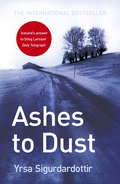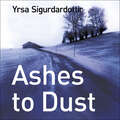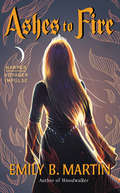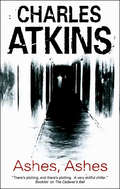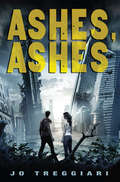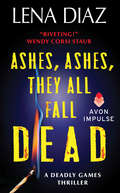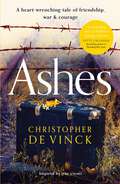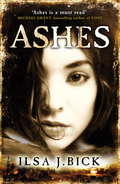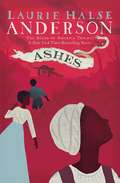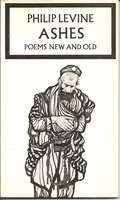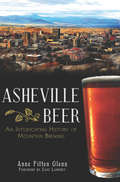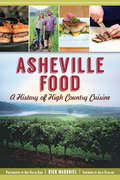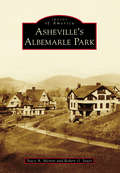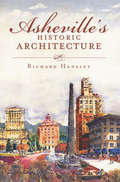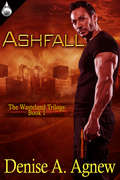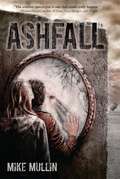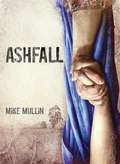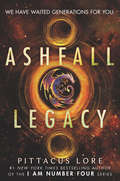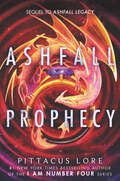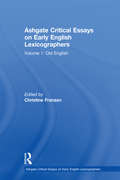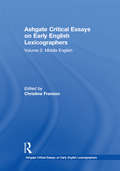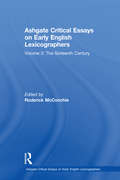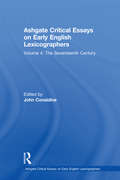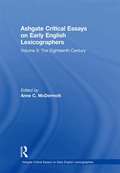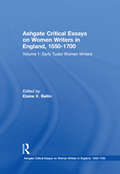- Table View
- List View
Ashes to Dust: Thora Gudmundsdottir Book 3 (Thora Gudmundsdottir #3)
by Yrsa SigurdardottirThe third crime novel from international bestseller Yrsa Sigurdardottir, ASHES TO DUST is tense, taut and terrifying - not to be missed for fans of Nordic Noir. Thora peered at the floor, but couldn't see anything that could have frightened Markus that much, only three mounds of dust. She moved the light of her torch over them. It took her some time to realize what she was seeing-- and then it was all she could do not to let the torch slip from her hand. 'Good God,' she said. She ran the light over the three faces, one after another. Sunken cheeks, empty eye-sockets, gaping mouths; they reminded her of photographs of mummies she'd once seen in National Geographic. 'Who are these people?''I don't know,' said Markus...Bodies are discovered in one of the excavated houses at a volcanic tourist attraction dubbed 'The Pompeii of the North'.Markus Magnusson, who was only a teenager when the volcano erupted, falls under suspicion and hires attorney Thora Gudmundsdottir to defend him - but when his childhood sweetheart is murdered his case starts to look more difficult, and the locals seem oddly reluctant to back him up . . .
Ashes to Dust: Thora Gudmundsdottir Book 3 (Thora Gudmundsdottir #3)
by Yrsa SigurdardottirThe third crime novel from international bestseller Yrsa Sigurdardottir, ASHES TO DUST is tense, taut and terrifying - not to be missed for fans of Nordic Noir. Thora peered at the floor, but couldn't see anything that could have frightened Markus that much, only three mounds of dust. She moved the light of her torch over them. It took her some time to realize what she was seeing-- and then it was all she could do not to let the torch slip from her hand. 'Good God,' she said. She ran the light over the three faces, one after another. Sunken cheeks, empty eye-sockets, gaping mouths; they reminded her of photographs of mummies she'd once seen in National Geographic. 'Who are these people?''I don't know,' said Markus . . . Bodies are discovered in one of the excavated houses at a volcanic tourist attraction dubbed 'The Pompeii of the North'.Markus Magnusson, who was only a teenager when the volcano erupted, falls under suspicion and hires attorney Thora Gudmundsdottir to defend him - but when his childhood sweetheart is murdered his case starts to look more difficult, and the locals seem oddly reluctant to back him up . . .(P) 2022 Hodder & Stoughton Limited
Ashes to Fire: Creatures of Light, Book 2 (Creatures of Light #2)
by Emily B. Martin“You are a country.”Those words have been the guiding force behind Queen Mona’s every move since she was a little girl—the idea that all her actions and desires were, first and foremost, decided based on what was best for Lumen Lake. It had kept her alive after the Alcoran invasion, it had driven her to retake her country, and now it is the steely resolve she needs to finally confront the despotic Seventh King, Celeno.But when her diplomatic mission finds herself on the run through the swamps of Cyprien—accompanied by the unlikeliest group of companions—Mona discovers that while she is her country, she is also someone who has been sheltered by principles and bound by past mistakes. Now she must struggle to reshape her view of the world and face intimate new truths—not only for the good of her country, but for herself, as well. A desperate journey to secure peace, and an even greater journey to discover herself, Ashes to Fire is the captivating and adventurous follow-up to Emily B. Martin’s Woodwalker—once more with cover art by the author herself!
Ashes, Ashes
by Charles AtkinsA Manhattan forensic psychologist is targeted by a madman in this &“taut, mind-blowing . . . Genuinely gripping thriller&” (Booklist). Dr. Barrett Conyors knows just how dangerous Richard Glash is. She&’s studied him. An easily triggered paranoid schizophrenic obsessed with Charles Manson and John Wayne Gacy, he&’s currently serving four life sentences for an appalling series of murders. What a terrible mistake it would be if he were to be transferred to a local, far less secure, hospital for the criminally insane. It&’s what Glash&’s bleeding-heart attorney Carla Phelps demands. It&’s what Barrett fears. The nightmare comes true when Glash escapes. Taking Barrett and Carla hostage is Glash&’s first move. His next is inconceivably chilling. Barrett and Carla won&’t be the only ones to suffer. What Glash has planned is to terrorize the entire city of New York. He&’s sworn to become one of the most notorious mass murderers in recorded history—and he&’s determined to make good on his promise.
Ashes, Ashes
by Jo TreggiariA thrilling tale of adventure, romance, and one girl's unyielding courage through the darkest of nightmares.Epidemics, floods, droughts--for sixteen-year-old Lucy, the end of the world came and went, taking 99% of the population with it. As the weather continues to rage out of control, and Sweepers clean the streets of plague victims, Lucy survives alone in the wilds of Central Park. But when she's rescued from a pack of hunting dogs by a mysterious boy named Aidan, she reluctantly realizes she can't continue on her own. She joins his band of survivors, yet a new danger awaits her: the Sweepers are looking for her. There's something special about Lucy, and they will stop at nothing to have her.
Ashes, Ashes, They All Fall Dead
by Lena DiazIf you liked Allison Brennans Prey, Hunt, Kill series, youll love Lena Diazs Nursery Rhyme series. This nursery rhyme will keep you awake. What she doesnt remember . . . One by one the letters arrive at the FBI office in Savannah, Georgia. Inside, each bears a name--a victim of a twisted crime--and the singsong phrase Ashes, ashes, they all fall dead. Special Agent Tessa James becomes obsessed with finding the killer whose victims are crying out to her for justice. Will kill her . . . When sexy, brilliant consultant Matt Buchanan is paired with Tessa to discover whos sending the "Ashes" letters, he discovers a serial arsonist who is leaving nothing but murder in his wake. Inexplicably, the clues point to Tessa herself, forcing her to realize that if she cant remember the forgotten years of her past, the name on the next letter will be hers.
Ashes: A WW2 historical fiction inspired by true events. A story of friendship, war and courage
by Christopher de VinckA deeply touching novel about two young women whose differences, which once united them, will tear them apart forever, during Hitler&’s Nazi occupation of Belgium and France. Based on true events.For fans of All The Light We Cannot See and Tattooist of Auschwitz. Belgium, July 1939: Simone Lyon is the daughter of a Belgium national hero, the famous General Joseph Lyon. Her best friend Hava Daniels, is the eldest daughter of a devout Jewish family. Despite growing up in different worlds, they are inseparable.But when, in the spring of 1940, Nazi planes and tanks begin bombing Brussels, their resilience and strength are tested. Hava and Simone find themselves caught in the advancing onslaught and are forced to flee.In an emotionally-charged race for survival, even the most harrowing horrors cannot break their bonds of love and friendship. The two teenage girls, will see their innocence fall, against the ugly backdrop of a war dictating that theirs was a friendship that should never have been.
Ashes: Book 1 (The Ashes Trilogy #1)
by Ilsa J. BickA cataclysmic event. A dramatically changed world. A zombie army. Can three kids really survive... and who can they trust?Alex has run away and is hiking through the wilderness with her dead parents' ashes, about to say goodbye to the life she no longer wants to live. But then the world suddenly changes. An electromagnetic pulse sweeps through the sky zapping every electronic device and killing the vast majority of adults. For those spared, it's a question of who can be trusted and who has changed... Everyone still alive has turned - some for the better (those who acquired a superhuman sense) while others for the worse (those who acquired a taste for human flesh). Desperate to find out what happened and to avoid the zombies that are on the hunt, Alex meets up with Tom - an Army veteran who escaped one war only to find something worse at home - and Ellie, a young girl whose grandfather was killed by the electromagnetic pulse. This improvised family will have to use every ounce of courage they have just to find food, shelter, while fighting off the 'Changed' and those desperate to stay alive. A tense and involving adventure with shocks and sudden plot twists that will keep teen and adult readers gripped.
Ashes: Chains; Forge; Ashes (The Seeds of America Trilogy #Bk. 3)
by Laurie Halse AndersonReturn to the American Revolution in this blistering conclusion to the trilogy that began with the bestselling National Book Award Finalist Chains and continued with Forge, which The New York Times called "a return not only to the colonial era but to historical accuracy."As the Revolutionary War rages on, Isabel and Curzon have narrowly escaped Valley Forge--but their relief is short-lived. Before long they are reported as runaways, and the awful Bellingham is determined to track them down. With purpose and faith, Isabel and Curzon march on, fiercely determined to find Isabel's little sister Ruth, who is enslaved in a Southern state--where bounty hunters are thick as flies. Heroism and heartbreak pave their path, but Isabel and Curzon won't stop until they reach Ruth, and then freedom, in this grand finale to the acclaimed Seeds of America trilogy from Laurie Halse Anderson.
Asheville Beer: An Intoxicating History of Mountain Brewing (American Palate)
by Anne Fitten GlennDrinking local harks back to the founding of Asheville in 1798. Whether it be moonshine or craft beer, the culture of local hooch is deeply ingrained in the mountain dwellers of Western North Carolina. Both residents and visitors alike enjoy Asheville's wealth of breweries, brewpubs, beer festivals and dedicated retailers. That enthusiasm earned the city the coveted Beer City, USA title year after year and prompted West Coast beer giants Sierra Nevada, New Belgium and Oskar Blues to establish production facilities here. Beer writer and educator Anne Fitten Glenn recounts this intoxicating history, from the suds-soaked saloons of 'Hell's Half Acre" to the region's explosion into a beer Mecca.
Asheville Food: A History of High Country Cuisine (American Palate)
by Rick McdanielThirty years ago, the mountain city of Asheville was known for little more than the Biltmore Estate. Since then, the sleepy town has become a nationally recognized food mecca, a hot spot for food celebrities and a bustling hub of microbreweries. Food historian and author Rick McDaniel traces the rise of the Asheville food scene from its early eateries to the pioneering chefs who put Asheville on the culinary map and the new generation of stars who command the kitchens at the city's hottest new restaurants. A founding city of the farm-to-table movement, Asheville is proud of its local food and drink, appearing on creative menus throughout the city and in the pages of the national food media. Join McDaniel as he embarks on a mouthwatering journey to explore the farmers, chefs, markets and history that have shaped Asheville's rich food heritage.
Asheville's Albemarle Park
by Robert O. Sauer Stacy A. MertenAlbemarle Park was envisioned as a picturesque mountainside resort in north Asheville. It was a great success due to the collaborative efforts of railroad executive William Greene Raoul and his son Thomas; Bradford Gilbert, architect of New York City's first skyscraper; and Samuel Parsons Jr., landscape architect for the City of New York. The Manor and its surrounding cottages served as an alternative to standard late-19th-century Asheville hotels and boardinghouses. Dances, plays, bowling, archery, golf, motoring, and equestrian events were available for guests to enjoy, and meals were sourced from The Manor's own farm. Notable guests of The Manor included Eleanor Roosevelt and Grace Kelly. It was also a film set for The Last of the Mohicans. Consisting of enchanting architecture and romantic landscaping, Albemarle Park was listed in the National Register of Historic Places in 1977 and as a local historic district in 1989. Through family archives, private collections, and ephemera, Asheville's Albemarle Park showcases the history of this significant Asheville neighborhood.
Asheville's Historic Architecture (Landmarks)
by Richard HansleyAsheville, known for its architectural diversity and intriguing Art Deco style, has been fortunate in attracting brilliant architects who, with imaginative foresight and design expertise, have created lasting testaments in brick and stone. Local architectural enthusiast Richard Hansley recounts the history behind dozens of Asheville's most prominent buildings and historical neighborhoods in Asheville's Historic Architecture. Discover how Douglas Ellington, Richard Sharp Smith, James Vester Miller and Tony Lord influenced this busy metropolis, as landmarks like the Jackson Building, the Grove Park Inn and the Art Deco City Building were constructed along the city's thriving streets. These buildings have stood the test of time and remain as breathtaking in concept and appearance today as when first completed.
Ashfall
by Denise A. AgnewA strong-willed woman and a former Air Force pararescueman have learned to survive in a new world forged by an apocalypse no one could have stopped. Isolated and alone, Mally Andretti finds hope in the tantalizing voice she hears on her ham radio, a man who says he's her friend. But in a world-gone-crazy, danger looms around every corner and it's hard to know who to trust. Denise A. Agnew presents Ashfall, book one in her exciting new series, The Wasteland Trilogy.After surviving an apocalypse, lonely Mally should feel safe. Until a deep, mysterious voice over the ham radio invites her into soul deep conversation and awakens mental and physical cravings.Her voice calls on every fiercely protective instinctive inside Adam, and when she's in danger he'll do anything to protect her.Content Notes: Spicy, Urban Fantasy, Post-Apocalyptic, Suspense, Uniformed Heroes
Ashfall (Ashfall Series #1)
by Mike Mullin<P>Many visitors to Yellowstone National Park don't realize that the boiling hot springs and spraying geysers are caused by an underlying supervolcano, so large that the caldera can only be seen by plane or satellite. And by some scientific measurements, it could be overdue for an eruption. <P>For Alex, being alone for the weekend means freedom from his parents and the chance to play computer games and hang out with his friends without hassle from his mother. <P>Then the supervolcano erupts, plunging his hometown into a nightmare of darkness, ash, and violence. Alex begins a harrowing trek, searching for his family and finding help in Darla, his travel partner. Together they must find the strength and skills to survive and outlast an epic disaster.
Ashfall (Ashfall Trilogy)
by Mike MullinMany visitors to Yellowstone National Park don't realize that the boiling hot springs and spraying geysers are caused by an underlying supervolcano, so large that the caldera can only be seen by plane or satellite. And by some scientific measurements, it could be overdue for an eruption.For Alex, being left alone for the weekend means having the freedom to play computer games and hang out with his friends without hassle from his mother. Then the Yellowstone supervolcano erupts, plunging his hometown into a nightmare of darkness, ash, and violence. Alex begins a harrowing trek to seach for his family and finds help in Darla, a travel partner he meets along the way. Together they must find the strength and skills to survive and outlast an epic disaster.
Ashfall Legacy
by Pittacus LorePittacus Lore finished telling the story of the Lorien Nine in the New York Times bestselling I Am Number Four and Lorien Legacies Reborn series. Now he’s back to recount an all-new adventure rooted in the real mysteries surrounding Roswell, New Mexico, that will enthrall fans of Brandon Sanderson, Jay Kristoff, and Amie Kaufman. We have waited generations for you… Syd Chambers knows that there’s life on other planets because he’s descended from it. His father was from a distant world called Denza and has been missing—presumed dead—for years. When Syd discovers a device his father left behind which shows not only that he’s alive, but where he is, Syd must set out on a mission of his own. But along the way, he discovers a deadly, unbearable secret that could destroy Denza, Earth, and the universe.
Ashfall Prophecy
by Pittacus LorePittacus Lore finished telling the story of the Lorien Nine in the New York Times bestselling I Am Number Four and Lorien Legacies Reborn series. Now he’s back with the second installment in an all-new adventure duology rooted in the real mysteries surrounding Roswell, New Mexico, that will enthrall fans of Brandon Sanderson, Jay Kristoff, and Amie Kaufman. Syd Chambers grew up on Earth with his human mother and barely remembers his alien father from Denza, who left on a mission when Syd was very young. After leaving Earth, Syd learned the truth of his father’s disappearance on the planet Ashfall—his father had died protecting a devastating secret about the history between humans and Denzans.Syd is now faced with a choice—free humanity from imprisonment on Earth, which will allow them to come into physical power beyond their wildest dreams; or destroy Earth so that humans never have a chance to enslave, torment, and kill other species again. It has been prophesied that Syd is destined to become a world-killer, but Syd is determined to choose his own fate, and knows there must be another path forward that will honor his father’s sacrifice.
Ashgate Critical Essays on Early English Lexicographers: Volume 1: Old English (Ashgate Critical Essays on Early English Lexicographers)
by Christine FranzenAnglo-Saxon lexicography studies Latin texts and words. The earliest English lexicographers are largely unidentifiable students, teachers, scholars and missionaries. Materials brought from abroad by early teachers were augmented by their teachings and passed on by their students. Lexicographical material deriving from the early Canterbury school remains traceable in glossaries throughout this period, but new material was constantly added. Aldhelm and Ælfric Bata, among others, wrote popular, much studied hermeneutic texts using rare, exotic words, often derived from glossaries, which then contributed to other glossaries. Ælfric of Eynsham is a rare identifiable early English lexicographer, unusual in his lack of interest in hermeneutic vocabulary. The focus is largely on context and the process of creation and intended use of glosses and glossaries. Several articles examine intellectual centres where scholars and texts came together, for example, Theodore and Hadrian in Canterbury; Aldhelm in Malmesbury; Dunstan at Christ Church, Canterbury; Æthelwold in Winchester; King Æthelstan's court; Abingdon; Glastonbury; and Worcester.
Ashgate Critical Essays on Early English Lexicographers: Volume 2: Middle English (Ashgate Critical Essays on Early English Lexicographers)
by Christine FranzenThe teaching of Latin remained important after the Conquest but Anglo-Norman now became a language of instruction and, from the thirteenth century onwards, a language to be learned. During this period English lexicographers were more numerous, more identifiable and their works more varied, for example: the tremulous hand of Worcester created an Old English-Latin glossary, and Walter de Bibbesworth wrote a popular contextualized verse vocabulary of Anglo-Norman country life and activities. The works and techniques of Latin scholars such as Adam of Petit Point, Alexander Nequam, and John of Garland were influential throughout the period. In addition, grammarians' and schoolmasters' books preserve material which in some cases seems to have been written by them. The material discussed ranges from a twelfth-century glossary written at a minor monastic house to four large alphabetical fifteenth-century dictionaries, some of which were widely available. Some material seems to connect with the much earlier Old English glossaries in ways not yet fully understood.
Ashgate Critical Essays on Early English Lexicographers: Volume 3: The Sixteenth Century (Ashgate Critical Essays on Early English Lexicographers)
by Roderick McConchieLaying the foundations for the first monolingual dictionaries of English, the sixteenth century in English lexicography is here shown to form a bridge between the glossarial compilations which had slowly evolved during the Middle Ages, and the more recognisably modern dictionary incorporating synonymy, illustrative citations and other standard features. The articles collected here treat general lexicography and dictionaries in this period, their uses, and the state of research in this field. The volume also covers a fascinating and diverse collection of lexicographers, from the well known - John Palsgrave, Thomas Cooper, Thomas Elyot and John Florio - to those about whom next to nothing is known - Richard Howlet, John Baret and Peter Levens.
Ashgate Critical Essays on Early English Lexicographers: Volume 4: The Seventeenth Century (Ashgate Critical Essays on Early English Lexicographers)
by John ConsidineThree major developments in English lexicography took place during the seventeenth century: the emergence of the first free standing monolingual English dictionaries; the making of new kinds of English lexicons that investigated dialect or etymology or that keyed English to invented 'philosophical' languages; and the massive expansion of bilingual lexicography, which not only placed English alongside the European vernaculars but also handled the languages of the new world. The essays in this volume discuss not only the internal history of lexicography but also its wider relationships with culture and society.
Ashgate Critical Essays on Early English Lexicographers: Volume 5: The Eighteenth Century (Ashgate Critical Essays on Early English Lexicographers)
by Anne C. McDermottThe eighteenth century is renowned for the publication of Samuel Johnson's A Dictionary of the English Language, which reference sources still call the first English dictionary. This collection demonstrates the inaccuracy of that claim, but its tenacity in the public mind testifies to how decisively Johnson formed our sense of what a dictionary is. The essays and articles in this volume examine the already flourishing tradition of English lexicography from which Johnson drew, as represented by Kersey, Bailey, and Martin, as well as the flourishing contemporary trade in encyclopedic, technical, pronunciation, and bilingual lexicons.
Ashgate Critical Essays on Women Writers in England, 1550-1700: Volume 1: Early Tudor Women Writers (Ashgate Critical Essays on Women Writers in England, 1550-1700 #Vol. 1)
by Elaine V. BeilinThis volume includes leading scholarship on five writers active in the first half of the sixteenth century: Margaret More Roper, Katherine Parr, Anne Askew, Mildred Cooke Cecil and Anne Cooke Bacon. The essays represent a range of theoretical approaches and provide valuable insights into the religious, social, economic and political contexts essential for understanding these writers' texts. Scholars examine the significance of Margaret More Roper's translations and letters in the contexts of humanism, family relationships and changing cultural forces; the contributions of Katherine Parr and Anne Askew to Reformation discourses and debates; and the material presence of Mildred Cooke Cecil and Anne Cooke Bacon in the intellectual, religious and political life of their time. The introduction surveys the development of the field as an interdisciplinary project involving literature, history, classics, religion and cultural studies.
